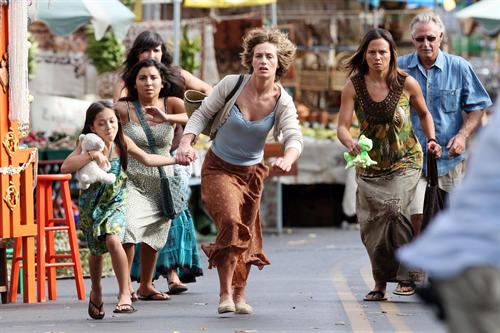Starting with Mystic River in 2001, Clint Eastwood has had a run of remarkable films that have all, in different ways, had death or loss as one of their major themes. His latest film, I believe, is a culmination of those films because in Hereafter he goes beyond death to speculate on the possibility of life after it.
Hereafter tells three separate stories that, through a series of coincidences, eventually connect. In the first story, Marie, (Cecil de France) a French newswoman, is on vacation with her boyfriend/co-worker when a tsunami overruns their resort. She is caught up in the wave and has a near death experience in which she has visions of something beyond this life and feelings of weightlessness and peace. This drastically affects her life, forcing her to take time off of work and to turn her attention from her book on a former French politician to a book about her experiences of the afterlife and the scientific, cultural efforts to cover-up the possibility of it. In the second story, Marcus and Jason (Frankie and George McLaren), two young British boys, live with their alcoholic, drug addicted mother. Marcus loses Jason when he dies in a tragic accident and eventually loses his mother to rehab. Marcus is placed in foster care and, desperately longing for his brother, begins to seek out information about the afterlife from a variety of religious and psychic sources. In the third story, George Lonegan (Matt Damon) is a “retired” psychic who attempts to live a normal life as a factory worker. His gift has become a burden that he can no longer bear because it prevents him from having normal relationships. He takes a cooking class at night and meets Melanie (Bryce Dallas Howard), and the two hit it off quickly. However, when she presses him to “read” her, despite his warnings of what could happen, he uncovers a painful memory from her past which pushes her away. George takes a trip to London where he crosses paths with both Marie and Marcus, the three of whom help each other heal and move forward in life.

As I mentioned above, Hereafter is the latest in an amazing film run a director who seems to be getting better with age. Like Gran Torino, it benefits from a fantastic score. The cinematography here is perfect, drawing heavily on low-lit scenes and often dismal, gray surroundings. The opening tsunami scene is a thrilling experience and feels as if Eastwood literally throws us into the torrential waves. The acting throughout is perfect, with Damon giving an especially moving performance, which, I think, is one of his better performances to date. Cecil de France as Marie is equally delightful to watch. Many films that employ separate but eventually converging stories aren’t often all that believable, but scriptwriter Peter Morgan manages to make the main characters’ connections quite convincing.
That the film focuses so heavily on a psychic and his ability to communicate with the dead might put off a number of viewers. However, to focus on this aspect of the film is to miss the larger point of the story. The connection between George and his “clients,” specifically their need for connection, to love and to feel loved, is what I think Eastwood is trying to get at here. The film’s limited glimpses of the hereafter, hazy visions of a dimly lit horizon populated with blurred figures, suggests not a certainty about its existence but, if I can put it this way, a hopeful uncertainty. Marie experiences feelings of weightlessness, feelings confirmed by others who have shared near-death experiences. Jason tells Marcus, through George, that you can be everything at once and that it’s really awesome. These statements are interesting because none of the characters appear to be explicitly Christian or religious. No violent tormenting hell awaits them, and this, I believe, is one of the film’s strengths. Hereafter reminds us of what we often forget, namely that for many people the human experience on earth is hell enough. From tsunamis to childhood deaths to betrayed relationships to sexual abuse to terrorist attacks, Eastwood conveys the brokenness of the human experience in vivid and painful ways. He seems to understand, like C. S. Lewis, that compared to the hereafter (if there is one), everything else is sorely lacking.

Another strength of Hereafter is its willingness to doubt. Through the character of Marcus, the film is skeptical of religious, New Age psychic, and nihilistic views of the afterlife, particularly ones that provide quick easy answers to what is one of life’s more taxing questions. Marcus sees through everyone who says that they “know” what lies beyond this life until he meets George. George tells him things that no one else could possibly know, yet when he begins to lose his connection with Jason, Marcus panics. George tells him that he has lost his connection with Jason and that he doesn’t know where he has gone. When Marcus presses him, reminding him of the countless readings that he has conducted, George tells him, “Yeah, but I still don’t know.” This type of uncertain humility is exactly was is needed in an age of violent (physically and verbally) religious extremism.
Hereafter (129 mins.) is rated PG-13 for mature thematic elements including disturbing disaster and accident images and for brief strong language and is in theaters everywhere.










